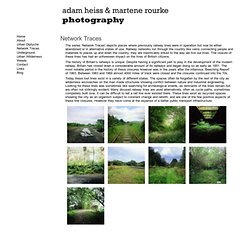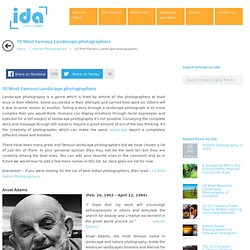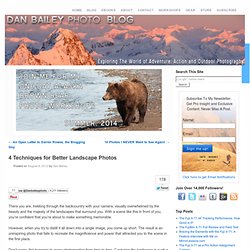

Sense of Place. Sense of Place est l’exposition centrale de cette nouvelle édition du Summer of Photography.

Le paysage a occupé une place prépondérante dans l’histoire de l’art en général, et dans celle de l’image, en particulier. Mais il relève aujourd’hui d’une actualité brûlante dictée par les impératifs écologiques de l’ère post-industrielle. Cette préoccupation de notre destinée collective nous invite à reconsidérer notre relation individuelle à notre environnement et à mieux l’inscrire dans nos traditions et notre histoire. Nous vivons aujourd’hui moins dans le paysage que nous ne vivons avec lui. Editorial - Why is Landscape Photography Often So Boring and Predictable? By Geoff Harris Looking to get beyond the ‘clicking by numbers’ approach to landscape photography?

Geoff Harris considers the limitations of checklist photography, and suggests some solutions… MARK LITTLEJOHN – Masters of Vision On any given Sunday the hills are alive with the sound of shutter releases clicking (with the mirror locked up, naturally) as landscape photographers up and down the country do their stuff. From the Scottish highlands to the south coast, people get up at stupid o’clock in all sorts of weather to crouch over tripods, painstakingly attaching filters and tut-tutting at histograms. So given all the effort and expensive gear involved, why do many landscape images look so similar – and is this a bad thing? Network Traces. The series ‘Network Traces’ depicts places where previously railway lines were in operation but now lie either abandoned or in alternative states of use.

Railway networks run through the country like veins connecting people and materials to places up and down the country, they are inextricably linked to the way we live our lives. The closure of these lines has had an unforeseen impact on the lives of British citizens. The history of Britain’s railways is unique. Despite having a significant part to play in the development of the modern railway, Britain has closed down a considerable amount of its railways and began doing so as early as 1851. The most notable period in the history of these closures however was in the years after the infamous ‘Beeching Report’ of 1963. 10 Most Famous Landscape photographers - Indian Digital Artists. Landscape photography is a genre which is tried by almost all the photographers at least once in their lifetime.

Some succeeded in their attempts and carried their work on. Others left it due to some reason or another. Telling a story through a landscape photograph is lot more complex than you would think. Humans can display emotions through facial expression and eyes but for a still subject of landscape photography it’s not possible. Conveying the complete story and message through still subjects require a great amount of out of the box thinking. Jennifer Broussard artwork. 5 ways to shoot landscapes you probably never thought to try. When you think about classic landscape photography, you probably envision towering mountains or quiet, serene seascapes.

But what do you do when these locations are unavailable… or maybe you simply want to shoot something different? In his latest tutorial expert Mark Hamblin suggests five simple ways you can shoot landscapes to come away with something creative and different. Scape #17 (2009), Available for Sale. New Landscape Photography. What's The Landscape Of Modern Landscape Photography? : The Picture Show. It used to be that landscape photography was about capturing the sublime, immortalizing the pristine — or at least about surveying uncharted territory. Think Timothy O'Sullivan's work out West . Arguably, if there was a person in the photo (unless strategically placed like a Caspar David Friedrich painting ), it wasn't a landscape.
These days, though, it's not easy to find a landscape that has been truly untouched by humans. And photography, naturally, has evolved to reflect that. In other words: We have become so closely entangled with the land that we almost can't remove ourselves from the frame, at least not honestly. Grand Canyon National Park, Ariz., circa 1941 Ansel Adams / U.S. New Landscape Photography. 4 Techniques for Better Landscape Photos.
There you are, trekking through the backcountry with your camera, visually overwhelmed by the beauty and the majesty of the landscapes that surround you.

With a scene like this in front of you, you’re confident that you’re about to make something memorable. However, when you try to distill it all down into a single image, you come up short. The result is an uninspiring photo that fails to recreate the magnificience and power that attracted you to the scene in the first place. Don’t worry, this happens to every photographer from time to time. Capturing the landscape in such a way that your photos have punch and drama is an endless pursuit that we all strive to do during our entire photographic lives. 1. Our eyes are drawn to bold colors, specifically those in the ‘warm’ and ‘hot’ end of the spectrum. By including, and focusing on hot colors, like reds, yellows and orange in your scene, you inherently help draw your viewer’s eye into the frame. 2.
Also, note the strong diagonal line. 3. 4. Landscape Photography, Flower & Tree Photos. Somerset Landscape Photography by Graham McPherson featuring 360° Imagery.